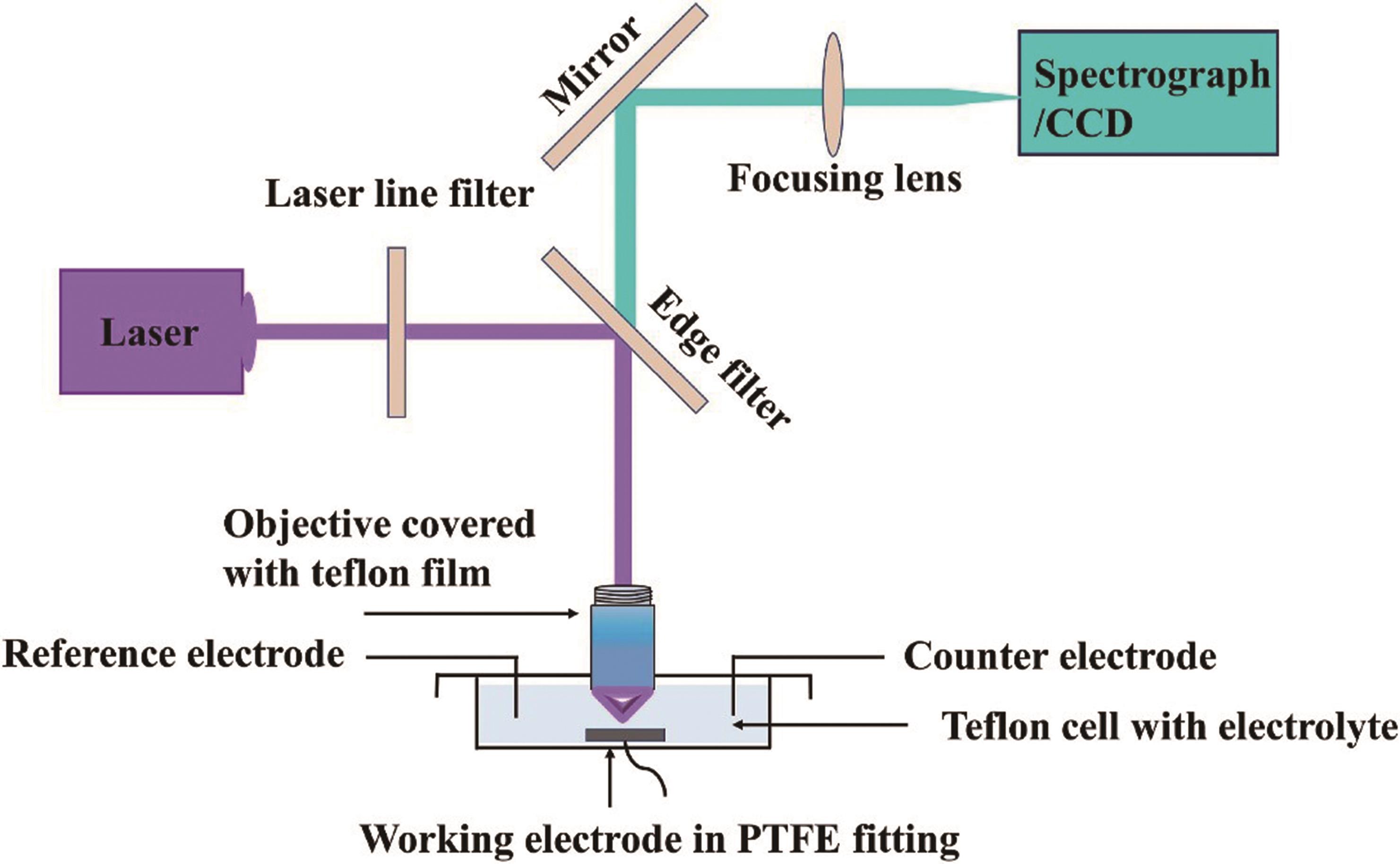
Chinese Journal of Applied Chemistry ›› 2022, Vol. 39 ›› Issue (4): 528-539.DOI: 10.19894/j.issn.1000-0518.220001
• Review • Previous Articles Next Articles
Progress of In situ Raman Study on the Dynamic Structure Performance Correlation of Water Splitting Catalysts
Hui-Bing TAO1, Zhen TIAN2, Yong XIE2, Yu SUN2, Li WANG1( ), Zhuo KANG2(
), Zhuo KANG2( ), Yue ZHANG2
), Yue ZHANG2
- 1.Academy for Advanced Interdisciplinary Science and Technology,University of Science and Technology Beijing,Beijing 100083,China
2.School of Materials Science and Engineering,Academy for Advanced Interdisciplinary Science and Technology,State Key Laboratory for Advanced Metals and Materials,University of Science and Technology Beijing,Beijing 100083,China
-
Received:2022-01-04Accepted:2022-02-21Published:2022-04-01Online:2022-04-19 -
Contact:Li WANG,Zhuo KANG -
Supported by:the National Key Research and Development Program of China(2018YFA0703503);the Overseas Expertise Introduction Projects for Discipline Innovation(B14003);the National Natural Science Foundation of China(51991340)
CLC Number:
Cite this article
Hui-Bing TAO, Zhen TIAN, Yong XIE, Yu SUN, Li WANG, Zhuo KANG, Yue ZHANG. Progress of In situ Raman Study on the Dynamic Structure Performance Correlation of Water Splitting Catalysts[J]. Chinese Journal of Applied Chemistry, 2022, 39(4): 528-539.
share this article
Add to citation manager EndNote|Ris|BibTeX
URL: http://yyhx.ciac.jl.cn/EN/10.19894/j.issn.1000-0518.220001
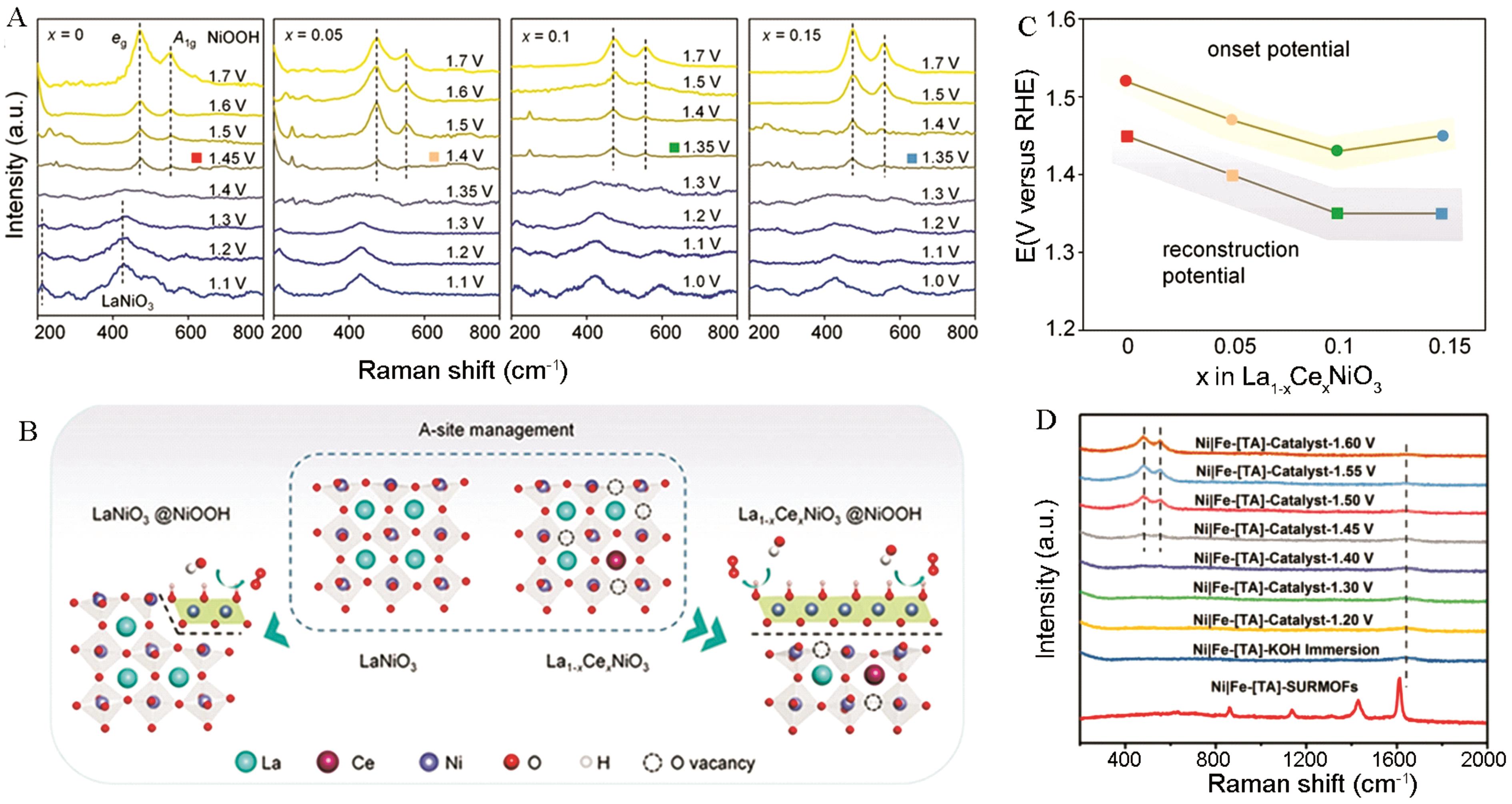
Fig.2 (A) In situ Raman spectra of La1-x Ce x NiO3 (x=0, 0.05, 0.1 and 0.15) during the OER process (1.0~1.7 V vs RHE). (B) The surface reconstruction process of La1-x Ce x NiO3 to active structure of NiOOH by the A-site management of Ce substitution strategy. The correlation between surface reconstruction potential and the corresponding onset potential for OER. (C) The correlation between surface reconstruction potential and the corresponding onset potential for OER[33]. (D) In situ Raman spectra collected during the OER process in 0.1 mol/L KOH within a low-wavenumber region of 200~2000 cm-1[42]
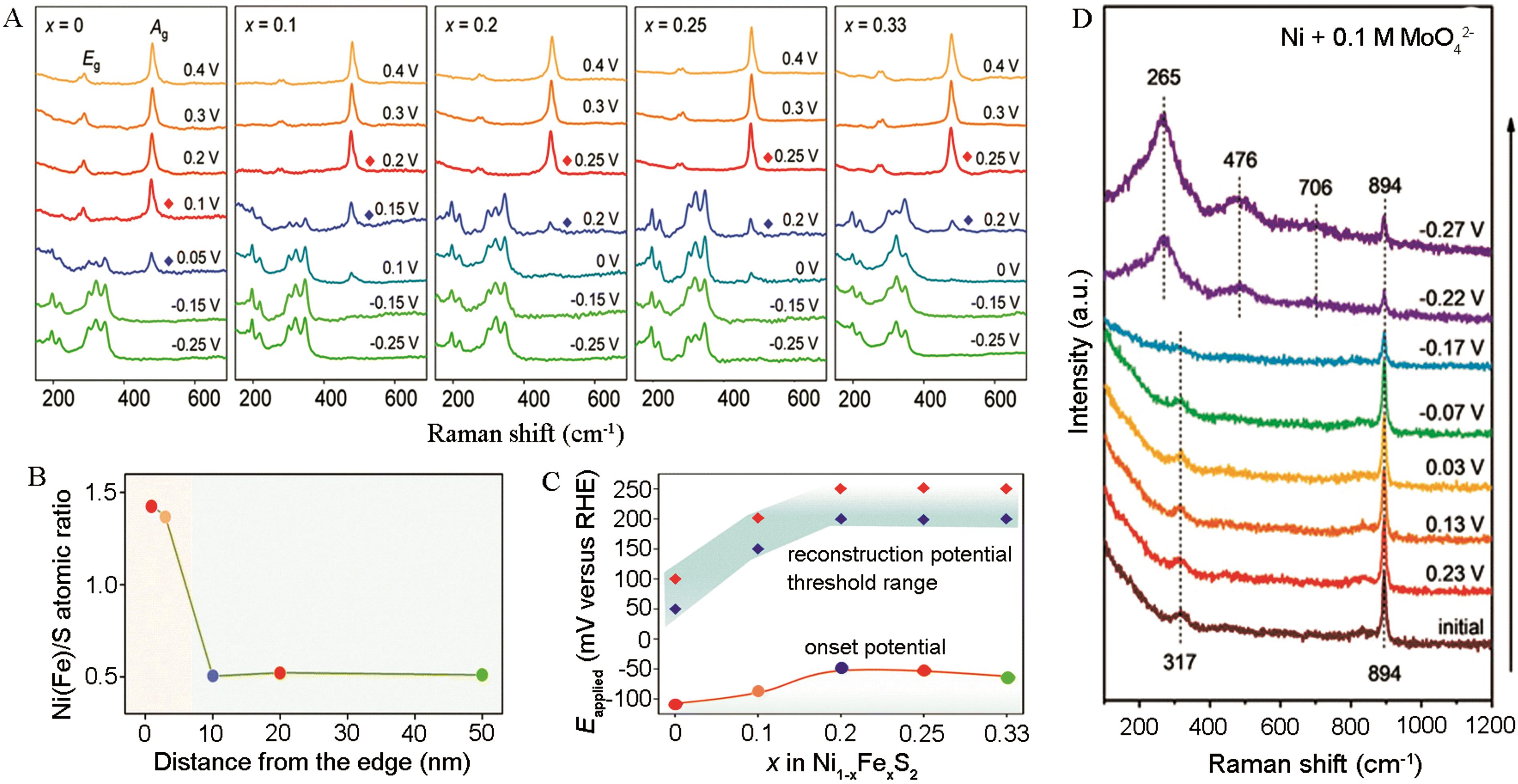
Fig.3 (A) In situ Raman spectra of the Ni1-x Fe x S2 (x=0, 0.1, 0.2, 0.25 and 0.33) samples at the potentials of 0.4 to -0.25 V versus the reversible hydrogen electrode (vs. RHE) in 1 mol/L KOH. (B) Elemental composition of post-electrolysis Ni0.8Fe0.2S2 determined from EDS at a series of spots along a line from the crystallite edge to the bulk reveals the variation in Ni(Fe)∶S composition across the crystallite. (C) The surface reconstruction potential threshold range for the Ni1-x Fe x S2 (x=0~0.33) samples, and the corresponding onset potentials of hydrogen evolution are plotted to show the dynamic correlation of structure-activity. The red diamond dots represent the final potential of the existence of Raman peaks for the Ni1-x Fe x S2 structures, and the blue diamond dots stand for the potential of emerging Ni3S2 Raman peaks[44]. (D) Potential-dependent in situ Raman spectra of metal Ni with 0.1 mol/L MoO42-[45]
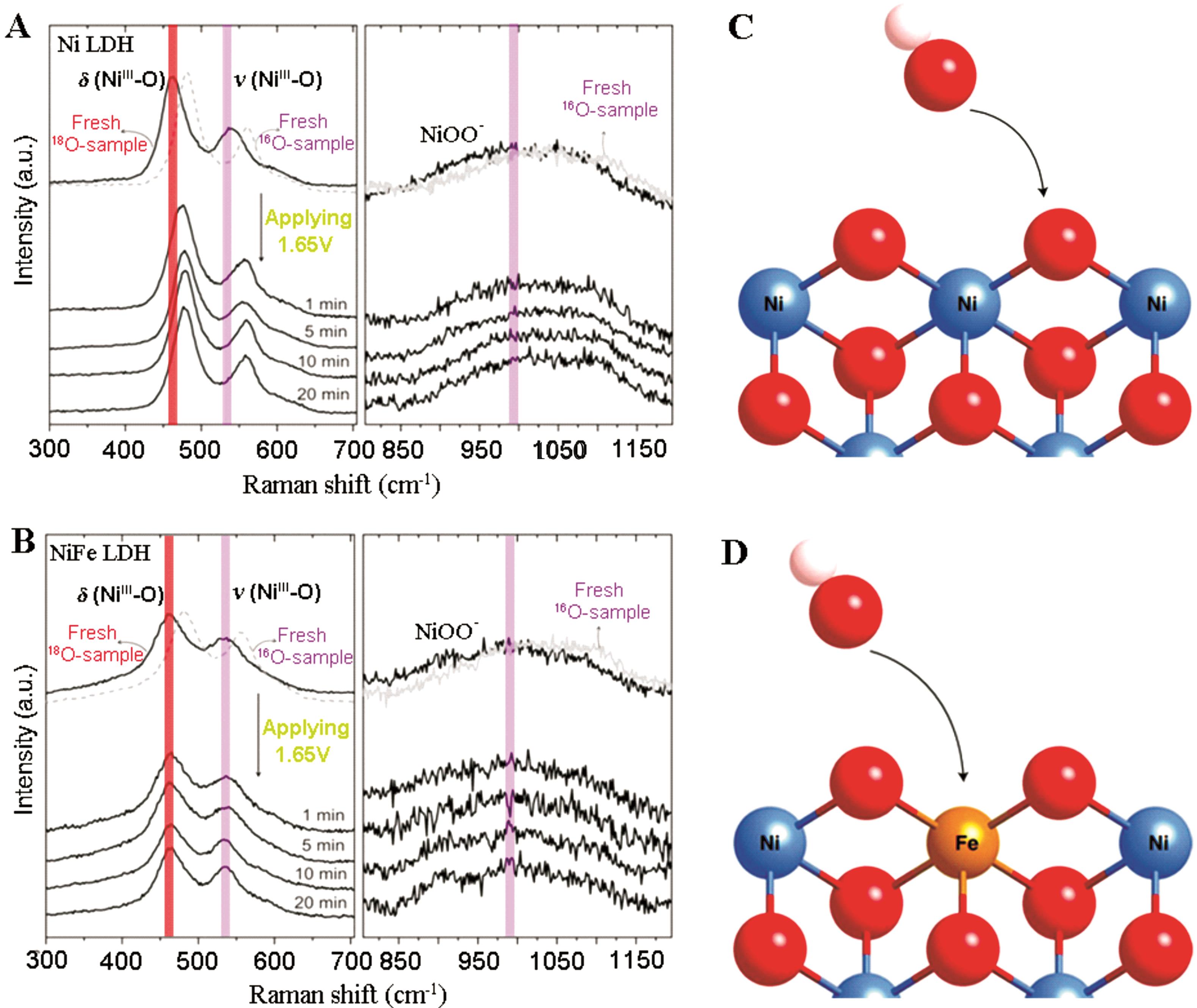
Fig.4 In?situ Raman spectrum of 18O labeled (A) Ni LDHs and (B) NiFe LDHs measured at 1.65 V (vs. RHE) in 0.1 mol/L KOH. The left column and right column represent the NiOOH and NiOO species, respectively. (C) Participation of lattice oxygen in Ni and NiCo LDHs. (D) Nonparticipation of lattice oxygen on NiFe LDH. M=Ni or Co[50]
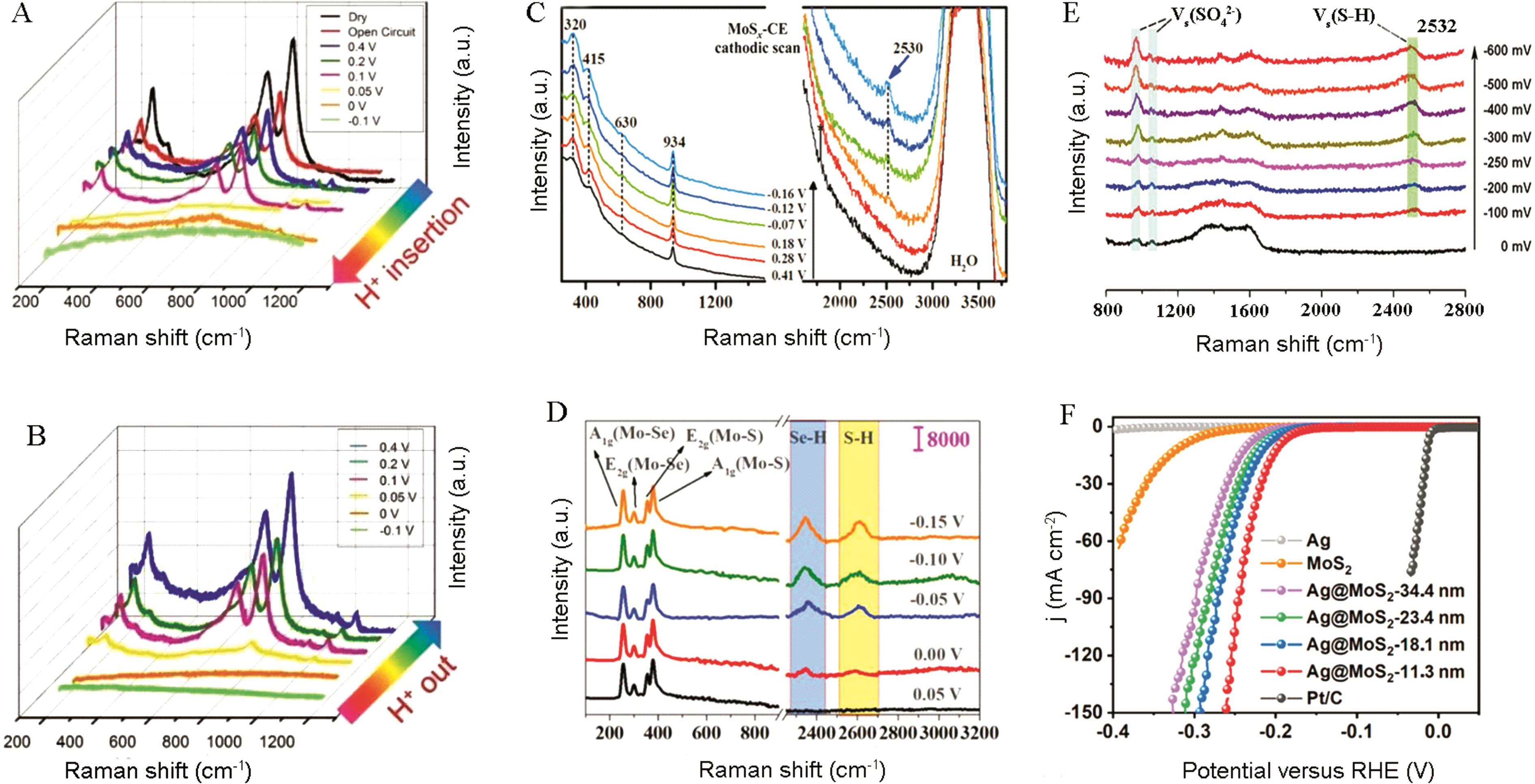
Fig.5 (A) and (B) in situ Raman spectra of Pt-WO3 from 0.4 to -0.1 V[54]. (C) In situ Raman spectrum of cathodically deposited MoSx at different cathodic potential in 1 mol/L HClO4[59]. (D) In situ Raman spectra of the sample MoS0.9Se1.1 at voltages of 0.05, 0.00, -0.05, -0.10 and -0.15 V[60] respectively. (E) In situ electrochemical surface-enhanced Raman spectroscopy (EC-SERS) of HER on Ag@MoS2 with size of (23.4 ± 3.8) nm in 0.5 mol/L H2SO4 electrolyte. (F) LSV curves for HER measured on the commercial Pt/C, Ag nanocrystals, MoS2 nanosheets, and Ag@MoS2 with different sizes[61]
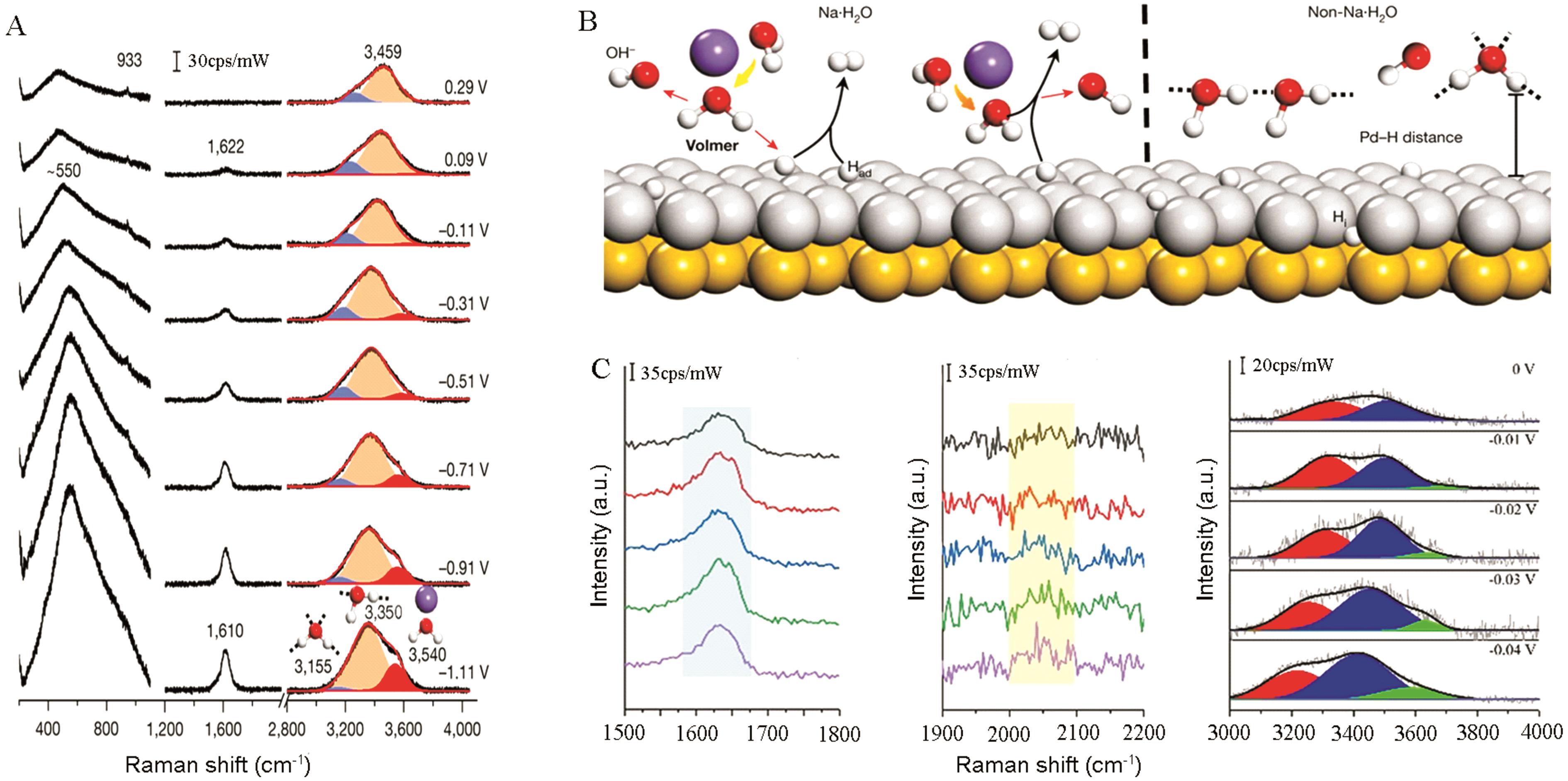
Fig.6 (A) In situ Raman spectra of interfacial water on a Pd (111) electrode in a 0.1 mol/L NaClO4 solution (pH=11). Gaussian fits of three O—H stretching modes are shown in blue, orange and red, respectively. c.p.s., counts per second. (B) Schematic showing interfacial water dissociation on a Pd (111) surface (Au (111) coated with Pd monolayer)[21]. (C) In situ electrochemical Raman spectra at the Acid-PtNi1.5 surface in 0.1 mol/L NaOH[66]
| 1 | DÜRR R N, MALTONI P, TIAN H N, et al. From NiMoO4 to γ-NiOOH: detecting the active catalyst phase by time resolved in situ and operando Raman spectroscopy[J]. ACS Nano, 2021, 15(8): 13504-13515. |
| 2 | 蒙阳, 杨婵, 彭娟. 基于铁、钴、镍金属磷化物纳米催化剂的碱性条件下电解水制氢的研究进展[J]. 应用化学, 2020, 37(7): 733-745. |
| MENG Y, YANG C, PENG J. Progress in iron, cobalt and nickel-based metal phosphide nano-catalysts for hydrogen production under alkaline conditions[J]. Chinese J Appl Chem, 2020, 37(7): 733-745. | |
| 3 | SENTHIL R D, CHUAH X F, LU S Y, et al. In situ grown bimetallic MOF-based composite as highly efficient bifunctional electrocatalyst for overall water splitting with ultrastability at high current densities[J]. Adv Energy Mater, 2018, 8: 1801065. |
| 4 | LIAO X B, LU R H, XIA L X, et al. Density functional theory for electrocatalysis[J]. Energy Environ Mater, 2022, 5(1): 157-185. |
| 5 | WANG Q C, LEI Y P, WANG Y C, et al. Atomic-scale engineering of chemical-vapor-deposition-grown 2D transition metal dichalcogenides for electrocatalysis[J]. Energy Environ Sci, 2020, 13: 1593-1616. |
| 6 | FENG K, WANG Y N, GUO M, et al. In‑situ/operando techniques to identify active sites for thermochemical conversion of CO2 over heterogeneous catalysts[J]. J Energy Chem, 2021, 62: 153-171. |
| 7 | ZHU Y P, WANG J L, CHU H, et al. In situ/operando studies for designing next-generation electrocatalysts[J]. ACS Energy Lett, 2020, 5: 1281-1291. |
| 8 | WANG J, GAO Y, KONG H, et al. Non-precious-metal catalysts for alkaline water electrolysis: operando characterizations, theoretical calculations, and recent advances[J]. Chem Soc Rev, 2020, 49: 9154-9196. |
| 9 | KUAI C G, XU Z R, XI C, et al. Phase segregation reversibility in mixed-metal hydroxide water oxidation catalysts[J]. Nat Catal, 2020, 3: 743-753. |
| 10 | PISHGAR S, GULATI S, STRAIN J M, et al. In situ analytical techniques for the investigation of material stability and interface dynamics in electrocatalytic and photoelectrochemical applications[J]. Small Methods, 2021, 5: 2100322. |
| 11 | WANG X, ZHANG Y W, WU J, et al. Single-atom engineering to ignite 2D transition metal dichalcogenide based catalysis: fundamentals, progress, and beyond[J]. Chem Rev, 2022, 122(1): 1273-1348. |
| 12 | LORIDANT S. Raman spectroscopy as a powerful tool to characterize ceria-based catalysts[J]. Catal Today, 2021, 373: 98-111. |
| 13 | XU Z Z, LIANG Z B, GUO W H, et al. In situ/operando vibrational spectroscopy for the investigation of advanced nanostructured electrocatalysts[J]. Coordin Chem Rev, 2021, 436: 213824. |
| 14 | WEI J, QIN S N, YANG J, et al. Probing single-atom catalysts and catalytic reaction processes by shell-isolated nanoparticle-enhanced Raman spectroscopy[J]. Angew Chem Int Ed, 2021, 60: 9306-9310. |
| 15 | GRAF M, VONBUN-FELDBAUER G B, KOPER M T M. Direct and broadband plasmonic charge transfer to enhance water oxidation on a gold electrode[J]. ACS Nano, 2021, 15(2): 3188-3200. |
| 16 | LI W Q, ZHOU R Y, WANG X T, et al. Identification of the molecular pathways of RuO2 electroreduction by in situ electrochemical surface-enhanced Raman spectroscopy[J]. J Catal, 2021, 400: 367-371. |
| 17 | BAI L, HSU C S, ALEXANDER D T L, et al. Double-atom catalysts as a molecular platform for heterogeneous oxygen evolution electrocatalysis[J]. Nat Energy, 2021, 6: 1054-1066. |
| 18 | LI L G, BU L Z, HUANG B L, et al. Compensating electronic effect enables fast site-to-site electron transfer over ultrathin RuMn nanosheet branches toward highly electroactive and stable water splitting[J]. Adv Mater, 2021: 2105308. |
| 19 | FLEISCHMAN M, HENDRA P J, MCQUILLAN A J. Long-range manifestation of surface-enhanced Raman scattering[J]. Chem Phys Lett, 1974, 26: 163-166. |
| 20 | WANG X, HUANG S C, HU S, et al. Fundamental understanding and applications of plasmon-enhanced Raman spectroscopy[J]. Nat Rev Phys, 2020, 2: 253-271. |
| 21 | WANG Y H, ZHENG S S, YANG W M. In situ Raman spectroscopy reveals the structure and dissociation of interfacial water[J]. Nature, 2021, 600: 81-85. |
| 22 | HARTMAN T, GEITENBEEK R G, WONDERGEM C S, et al. Operando nanoscale sensors in catalysis: all eyes on catalyst particles[J]. ACS Nano, 2020, 14: 3725-3735. |
| 23 | CHENG Y, YUAN P F, XU X H, et al. S-edge-rich MoxSy arrays vertically grown on carbon aerogels as superior bifunctional HER/OER electrocatalysts[J]. Nanoscale, 2019, 11: 20284. |
| 24 | ZHANG H, DUAN S, RADJENOVIC P M, et al. Core-shell nanostructure-enhanced raman spectroscopy for surface catalysis[J]. Acc Chem Res, 2020, 53: 729-739. |
| 25 | ZHANG J, ZHANG Q Y, FENG X L. Support and interface effects in water-splitting electrocatalysts[J]. Adv Mater, 2019, 31: 1808167. |
| 26 | SHI S, QIN D. Bifunctional metal nanocrystals for catalyzing and reporting on chemical reactions[J]. Angew Chem Int Ed, 2020, 59: 3782 -3792. |
| 27 | LAI W, GE L H, LI H M, et al. In situ Raman spectroscopic study towards the growth and excellent HER catalysis of Ni/Ni(OH)2 heterostructure[J]. Int J Hydrogen Energy, 2021, 46: 26861-26872. |
| 28 | HU C J, HU Y F, FAN C H, et al. Surface-enhanced Raman spectroscopic evidence of key intermediate species and role of NiFe dual-catalytic center in water oxidation[J]. Angew Chem Int Ed, 2021, 60: 19774-19778. |
| 29 | NGUYEN T X, LIAO Y C, LIN C C, et al. Advanced high entropy perovskite oxide electrocatalyst for oxygen evolution reaction[J]. Adv Funct Mater, 2021, 31: 2101632. |
| 30 | SARI F N I, ABDILLAH S, TING J M. FeOOH-containing hydrated layered iron vanadate electrocatalyst for superior oxygen evolution reaction and efficient water splitting[J]. Chem Eng J, 2021, 416: 129165. |
| 31 | BOUCLY A, ARITIGLIA L, FABBRI E, et al. Direct evidence of cobalt oxyhydroxide formation on a La0.2Sr0.8CoO3 perovskite water splitting catalyst[J]. J Mater Chem A, 2022, 10: 2434-2444. |
| 32 | OH N K, SEO J, LEE S, et al. Highly efficient and robust noble-metal free bifunctional water electrolysis catalyst achieved via complementary charge transfer[J]. Nat Commun, 2021, 12: 4606. |
| 33 | SUN Y, LI R, CHEN X X, et al. A-site management prompts the dynamic reconstructed active phase of perovskite oxide OER catalysts[J]. Adv Energy Mater, 2021, 11: 2003755. |
| 34 | MENG T, LI Q, YAN M X, et al. Electrochemically induced in‑situ surface self-reconstruction on Ni, Fe, Zn ternary-metal hydroxides towards the oxygen-evolution performance[J]. Chem Eng J, 2021, 410: 128331. |
| 35 | WU J, YU Z J, ZHANG Y Y, et al. Understanding the effect of second metal on CoM (M = Ni, Cu, Zn) metal-organic frameworks for electrocatalytic oxygen evolution reaction[J]. Small, 2021: 2105150. |
| 36 | ZHANG W D, HU Q T, WANG L L, et al. In‑situ generated Ni-MOF/LDH heterostructures with abundant phase interfaces for enhanced oxygen evolution reaction[J]. Appl Catal B: Environ, 2021, 286: 119906. |
| 37 | CHOI Y, CHENA T, KIM D, et al. Transformation of microwave synthesized highly uniform FeMo-MIL-88B nanorod to oxynitride derivate for overall water splitting reaction[J]. Appl Mater Today, 2021, 24: 101093. |
| 38 | ZHAO S L, TAN C H, HE C T, et al. Structural transformation of highly active metal-organic framework electrocatalysts during the oxygen evolution reaction[J]. Nat Energy, 2020, 5: 881-890. |
| 39 | ZHAO S L, WANG Y, DONG J C, et al. Ultrathin metal-organic framework nanosheets for electrocatalytic oxygen evolution[J]. Nat Energy, 2016, 1(12): 1-10. |
| 40 | GUO J, QIN Y T, ZHU Y F, et al. Metal-organic frameworks as catalytic selectivity regulators for organic transformations[J]. Chem Soc Rev, 2021,50: 5366. |
| 41 | ZHENG W, LIU M, LEE L Y S. Electrochemical instability of metal-organic frameworks: in situ spectroelectrochemical investigation of the real active sites[J]. ACS Catal, 2020, 10: 81-92. |
| 42 | HOU S J, LI W J, WATZELE S, et al. Metamorphosis of heterostructured surface-mounted metal-organic frameworks yielding record oxygen evolution mass activities[J]. Adv Mater, 2021, 33: 2103218. |
| 43 | CHENG C C, CHENG P Y, HUANG C L, et al. Gold nanocrystal decorated trimetallic metal organic frameworks as high performance electrocatalysts for oxygen evolution reaction[J]. Appl Catal B: Environ, 2021, 286: 119916. |
| 44 | SUN Y, WU J, ZHANG Z, et al. Phase reconfiguration of multivalent nickel sulfides in hydrogen evolution[J]. Energy Environ Sci, 2022, 15: 633-644. |
| 45 | DU W, SHI Y W, ZHOU W, et al. Unveiling the in situ dissolution and polymerization of Mo in Ni4Mo alloy for promoting the hydrogen evolution reaction[J]. Angew Chem Int Ed, 2021, 60: 7051-7055. |
| 46 | ZE H J, CHEN X, WANG X T, et al. Molecular insight of the critical role of Ni in Pt-based nanocatalysts for improving the oxygen reduction reaction probed using an in situ SERS borrowing strategy[J]. J Am Chem Soc, 2021, 143 (3): 1318-1322. |
| 47 | BALAJI R, MAHESHWARAN S, CHEN S M, et al. High-performance catalytic strips assembled with BiOBr Nano-rose architectures for electrochemical and SERS detection of theophylline[J]. Chem Eng J, 2021, 425: 130616. |
| 48 | LONG C, HAN J Y, GUO J, et al. Operando toolbox for heterogeneous interface in electrocatalysis[J]. Chem Catal, 2021, 19: 509-522. |
| 49 | WANG X, ZHANG Y W, SI H N, et al. Single-atom vacancy defect to trigger high-efficiency hydrogen evolution of MoS2[J]. J Am Chem Soc, 2020, 142: 4298-4308. |
| 50 | LEE S, BANJAC K, LINGENFELDER M, et al. Oxygen isotope labeling experiments reveal different reaction sites for the oxygen evolution reaction on nickel and nickel iron oxides[J]. Angew Chem Int Ed, 2019, 58: 10295-10299. |
| 51 | MA M, KUMAR A, WANG D N, et al. Boosting the bifunctional oxygen electrocatalytic performance of atomically dispersed Fe site via atomic Ni neighboring[J]. Appl Catal B: Environ, 2020, 274: 119091. |
| 52 | PANG B B, LIU X K, LIU T Y, et al. Laser-assisted high-performance PtRu alloy for pH-universal hydrogen evolution[J]. Energy Environ Sci, 2022, 15: 102-108. |
| 53 | LEE W H, KO Y J, KIM J H, et al. High crystallinity design of Ir-based catalysts drives catalytic reversibility for water electrolysis and fuel cells[J]. Nat Commun, 2021, 12: 4271. |
| 54 | XIE C, CHEN W, DU S Q, et al. In‑situ phase transition of WO3 boosting electron and hydrogen transfer for enhancing hydrogen evolution on Pt[J]. Nano Energy 2020, 71: 104653. |
| 55 | WANG X, ZHANG Y W, SI H N, et al. Single-atom vacancy defect to trigger high-efficiency hydrogen evolution of MoS2[J]. J Am Chem Soc, 2020, 142: 4298-4308. |
| 56 | DAHIYA Y, HARIRAM M, KUMAR M, et al. Modified transition metal chalcogenides for high performance supercapacitors: current trends and emerging opportunities[J]. Coordin Chem Rev, 2021, 451: 214265. |
| 57 | HINNEMANN B, MOSES P G, BONDE J, et al. Biomimetic hydrogen evolution: MoS2 nanoparticles as catalyst for hydrogen evolution[J]. J Am Chem Soc, 2005, 127: 5308-5309. |
| 58 | JARAMILLO T F, JORGENSEN K P, BONDE J, et al. Identification of active edge sites for electrochemical H2 evolution from MoS2 nanocatalysts[J]. Science, 2007, 317: 100-102. |
| 59 | DENG Y L, TING L R L, NEO P H L, et al. Operando Raman spectroscopy of amorphous molybdenum sulfide (MoSx) during the electrochemical hydrogen evolution reaction: identification of sulfur atoms as catalytically active sites for H+ reduction[J]. ACS Catal, 2016, 6: 7790-7798. |
| 60 | GUO S H, LI Y H, TANG S W, et al. Monitoring hydrogen evolution reaction intermediates of transition metal dichalcogenides via operando Raman spectroscopy[J]. Adv Funct Mater, 2020, 30: 2003035. |
| 61 | CHEN J Z, LIU G G, ZHU Y Z, et al. Ag@MoS2 core-shell heterostructure as SERS platform to reveal the hydrogen evolution active sites of single-layer MoS2[J]. J Am Chem Soc, 2020, 142: 7161-7167. |
| 62 | SOLOMON G, LANDSTRÖM A, MAZZARO R, et al. NiMoO4@Co3O4 core-shell nanorods: in situ catalyst reconstruction toward high efficiency oxygen evolution reaction[J]. Adv Energy Mater, 2021, 11: 2101324. |
| 63 | FENG J X, WU J Q, TONG Y X, et al. Efficient hydrogen evolution on Cu nanodots-decorated Ni3S2 nanotubes by optimizing atomic hydrogen adsorption and desorption[J]. J Am Chem Soc, 2018, 140: 610-617. |
| 64 | BAI J, MEI J, LIAO T, et al. Molybdenum-promoted surface reconstruction in polymorphic cobalt for initiating rapid oxygen evolution[J]. Adv Energy Mater, 2022, 12(5): 213247. |
| 65 | XIA L, LI G K. Recent progress of microfluidics in surface-enhanced Raman spectroscopic analysis[J]. J Sep Sci, 2021, 44:1752-1768. |
| 66 | SHEN L F, LU B A, LI Y Y, et al. Interfacial structure of water as a new descriptor of the hydrogen evolution reaction[J]. Angew Chem Int Ed, 2020, 59: 22397-22402. |
| 67 | WEN B Y, CHEN Q Q, RADJENOVIC P M, et al. In situ surface-enhanced Raman spectroscopy characterization of electrocatalysis with different nanostructures[J]. Annu Rev Phys Chem, 2021, 72: 331-351. |
| 68 | CHEN H Q, ZOU L,WEI D Y, et al. In situ studies of energy-related electrochemical reactions using Raman and X-ray absorption spectroscopy[J]. Chinese J Catal, 2022, 43: 33-46. |
| 69 | HESS C. New advances in using raman spectroscopy for the characterization of catalysts and catalytic reactions[J]. Chem Soc Rev, 2021, 50: 3519-3546. |
| [1] | Hong-Li YU, Si-Yi ZHOU, Chen HONG, Wen LUO. A Flavone-based “Off-On” Fluorescence Probe for Detecting Butyrylcholinesterase in Living Cell [J]. Chinese Journal of Applied Chemistry, 2023, 40(4): 500-508. |
| [2] | Jin-Ping SONG, Qi MA, Xiao-Min LIANG, Jian-Peng SHANG, Chuan DONG. Neodymium and Nitrogen Co‑doped Carbon Dots with High Fluorescence Quantum Yield for Detection of Sulfasalazine and Hela Cell Imaging [J]. Chinese Journal of Applied Chemistry, 2022, 39(11): 1726-1734. |
| [3] | Zhen-Hua YANG, Xuan-Sen SUN, Yue-Xia ZHANG, Yu-Juan CAO, Qi-Qi ZHANG, Qiao-Zhi GUO, Xiao-Peng FAN, Zhong-Ping LI, Chuan DONG. Preparation of Nitrogen Sulfur Co⁃doped Carbon Dots with Nitrogen Sulfur and the Application for Detection of Oxytetracycline in Milk [J]. Chinese Journal of Applied Chemistry, 2022, 39(9): 1382-1390. |
| [4] | Jun-Jie CHENG, Zhi CAO, Can-Ran YANG, Lian-Shun LI, Jian WANG, Qing-Yu LIN. Quantitative Analysis with a Portable Remote Laser‑induced Breakdown Spectroscopy System [J]. Chinese Journal of Applied Chemistry, 2022, 39(9): 1447-1452. |
| [5] | Xin HE, Cai-Yun JIANG, Tao DING, Yu-Ping WANG. Reserch Progress of Preparation of Ordered Surface Enhanced Raman Scattering Substrate [J]. Chinese Journal of Applied Chemistry, 2022, 39(8): 1167-1176. |
| [6] | Xiao-Li ZHANG, Yu-Mei PENG, Qing-Wei WANG, Li-Xia QIN, Xiao-Xia LIU, Shi-Zhao KANG, Xiang-Qing LI. Construction of Nano Ag Modified TiO2 Nanotube Array Substrate for Surface Enhanced Raman Scattering Detection and Degradation of Tetracycline Hydrochloride [J]. Chinese Journal of Applied Chemistry, 2022, 39(7): 1147-1156. |
| [7] | Jing-Hui WEN, Bing ZHAO, Wei KAN, Li-Yan WANG, Li SUN, Tian-Shu SONG, Bo SONG. Synthesis of Isomers of Distinguishable Iron(Ⅲ) Fluorescent Probes and Application in Water Samples [J]. Chinese Journal of Applied Chemistry, 2022, 39(5): 787-796. |
| [8] | Jiu-Geng CHENG, Zhao-Hui SU. Quantitative Analysis of Phase Composition of Poly (1-butene) /Polypropylene Blends by Atomic Force Microscopy-Infrared [J]. Chinese Journal of Applied Chemistry, 2022, 39(02): 266-271. |
| [9] | HUANG Yi-Wen, WANG Li-Yan, ZHAO Bing, SONG Bo. Synthesis of Water Soluble Methoxynaphthene Hemicine for Detection of Chromium(Ⅲ) Ion [J]. Chinese Journal of Applied Chemistry, 2021, 38(11): 1503-1511. |
| [10] | LIU Qiao-Ling, REN Bo-Rong, LIU Rui-Rong, LI Yu-Xia, WANG Gui-Xiang, REN Zi-Wei, DONG Chuan. N-Doped Carbon Dots with Ratio Fluorescent Detection for Ag+ [J]. Chinese Journal of Applied Chemistry, 2021, 38(11): 1512-1520. |
| [11] | ZHANG Meng, CHEN Dong-Zhen, REN Yan-Wei, NING Pan. Sensing Interface Based on Nanoislandlike Sliver Film@Gold Nanotip for Surface Enhanced Raman Scattering Analysis of Dopamine [J]. Chinese Journal of Applied Chemistry, 2021, 38(7): 866-873. |
| [12] | WEN Guang-Ming, JIAO Ting, DU Xiao-Yan, LI Zhong-Ping. Preparation and Application of Sulfur and Nitrogen Co-doped Carbon Quantum Dots [J]. Chinese Journal of Applied Chemistry, 2021, 38(6): 722-730. |
| [13] | ZHANG Chun-Hui, LIU Xi-Jing, ZHANG Rong , TU Ya. Infrared Spectrum about the Different Extracts of Fructus Piperis Longi [J]. Chinese Journal of Applied Chemistry, 2021, 38(3): 271-275. |
| [14] | GUO Yong-Yan, TIAN Yan-Fei, DANG Ming-Ming, YANG Ping, LONG Yun-Fei. Preparation of Thiourea Coordinated Chromium Black T Stabilized Silver Nanoclusters under Alkaline Environment [J]. Chinese Journal of Applied Chemistry, 2021, 38(2): 195-201. |
| [15] | YAN Yuerong, GAO Chengzhuang, ZHANG Yanqing, CHU Wengya, LI Shuangshuang, ZHAO Wei, ZHOU Qun, LI Xiaowei. Surface-enhanced Infrared Absorption Spectroscopy of the Para-mercaptobenzoic acid on the Cobalt-island Film [J]. Chinese Journal of Applied Chemistry, 2015, 32(2): 221-224. |
| Viewed | ||||||
|
Full text |
|
|||||
|
Abstract |
|
|||||
